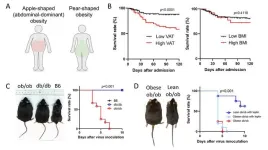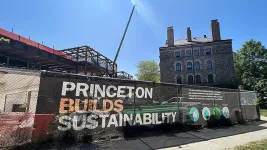(Press-News.org) UNIVERSITY PARK, Pa. — Millions of Americans over the age of 65 lack access to the social and emotional support they need for healthy aging, according to the Centers for Disease Control and Prevention. Non-white individuals in rural communities are especially susceptible. New research from Penn State found that the presence of social infrastructure — shared community spaces that are free or low cost to visit — in rural communities may help provide social and emotional support and promote healthy aging among older, non-white adults.
Danielle Rhubart, assistant professor of biobehavioral health and demography at Penn State and lead author of the study, explained that when people retire, they often lose social connections at work. Then, older friends, family members and acquaintances may die. Over time, many lose abilities like sight that help them participate in activities or maintain skills like driving. These changes can lead to a loss of social support. One-in-10 white adults over age 65 reported not receiving the emotional support they need, according to the researchers. The problem is more significant for non-white older adults, one-in-five of whom reported not receiving the emotional support they need. This can be especially true in rural areas, where access to social infrastructure like churches, coffee shops, libraries, parks, gyms and hair salons may be more limited.
In a recent publication in Rural Sociology, the researchers evaluated whether social infrastructure increases social and emotional support. They examined individuals’ perceptions of support using data from 110,850 rural older adults in the CDC's Behavioral Risk Factors Surveillance System paired with social infrastructure data from the National Neighborhood Data Archive.
They found that Black and Hispanic older adults were nearly two times more likely to report rarely or never getting the support they need relative to non-Hispanic, white older adults. The researchers noted, however, that rural Hispanic and Black older adults living in counties with more social infrastructure were more likely to report at least sometimes getting the support they need compared with those living in counties with less social infrastructure.
Rhubart said that social infrastructure can provide an important support system for people’s mental and emotional well-being.
“As people age, their social networks tend to shrink,” Rhubart said. “Retirement often starts the process, and networks continue to contract as people age. Additionally, reduced personal abilities can limit people’s opportunities to access and engage the social networks that remain.”
This reduced social contact contributes to reduced levels of support, and lower levels of social and emotional support can be related to a range of health problems including cognitive decline, depression, dissatisfaction with life and even early death.
Black and Hispanic older adults are at even more risk, according to Jennifer Kowalkowski, postdoctoral scholar in biobehavioral health and study coauthor.
"Historically, racist practices in society have contributed to poorer health among Hispanic and Black older adults," Kowalkowski said. "Connecting with others is often important for these groups — they have larger and more diverse social networks than white older adults — and it is through these connections that Hispanic and Black older adults are able to get the kind of support they need to maintain their health and well-being. The presence of social infrastructure provides physical spaces for these social networks to be developed and maintained."
People’s diminishing networks need not result in their total loss of support, however. A conceptual model used by the researchers proposes that all older people in a community benefit from social infrastructure, not just those who visit social infrastructure. The model suggests that a combination of intimate and casual encounters in these spaces leads to interactions that increase everyone’s senses of support.
A scenario that illustrates the theory, according to Rhubart, could be to consider social and emotional support for a hypothetical older woman with poor vision who does not often leave the house. If her brother runs into her pastor at a coffee shop and tells the pastor about his sister’s condition, the pastor may visit the woman. So, despite the woman not visiting the church or the coffee shop, her support is increased because both spaces exist in her community. And even if the pastor doesn’t visit the woman, hearing about her brother’s interaction and conversation with the pastor may help her feel connected to a larger network of support.
Rhubart said the findings in this research partially validate this theory, and she plans to continue research into the potential of social infrastructure to improve people’s health and well-being.
“As policymakers work to address loneliness and mental and emotional health among older adults, they do so with limited resources,” Rhubart said. “While direct support for individuals will always be critically important, this research is exciting because it suggests that we may be able to make inroads into supporting mental and emotional health by working at the community level. Research has shown that sidewalks and parks are important for supporting physical health. We need to apply this same community-level approach to mental and social health. Our research here suggests that social infrastructure might be a good place to start.”
Logan Wincott, undergraduate student in the Department of Sociology and Criminology and Rhubart’s former research assistant, also contributed to this research.
This research was supported by Penn State’s Population Research Institute and the National Institute on Aging-funded Interdisciplinary Network on Rural Population Health and Aging.
END
Community spaces may promote healthy aging for rural Black, Hispanic adults
2023-06-20
ELSE PRESS RELEASES FROM THIS DATE:
Concluding remarks & perspectives of Targeting Phage Therapy 2023
2023-06-20
The 6th World Congress on Targeting Phage Therapy 2023 that was held on June 1-2 in Paris, and gathered more than 150 attendees from 30+ different countries. Targeting Phage Therapy 2023 included more than 71 presentations between major talks, short orals, and posters.
The Chairman of the scientific committee Dr. Marvin Edeas Université de Paris, Cochin Institute, France, and Dr. Domenico Frezza, University of Roma Tor Vergata, Italy, stated: “It’s wonderful to hear that the speakers at the Targeting Phage Therapy 2023 conference delivered excellent presentations on a variety of fantastic topics. The fact ...
CEHD researchers receive funding for Appalachian Conservation Strategy Feasibility Pilot
2023-06-20
Sammie Powers, Assistant Professor, Recreation Management, School of Sport, Recreation, and Tourism Management (SRTM); Hung-Ling Liu, Associate Professor, Recreation Management, SRTM; and Ellen Rodgers, Associate Dean, College of Education and Human Development (CEHD), received funding from the Appalachian Trail Conservancy (ATC) for the project: "Appalachian Conservation Strategy Feasibility Pilot: Conservation and Human Dimensions Stakeholder Engagement Action Plan Project."
They are collaborating with Nate Trauntvein, Associate Professor, ...
Menon & Maribojoc receive funding for evaluation services for step ahead 2.0 – housing first support services pilot
2023-06-20
Menon & Maribojoc Receive Funding For Evaluation Services For Step Ahead 2.0 – Housing First Support Services Pilot
Nirup Menon, Professor, Information Systems and Operations Management (ISOM), and Roderick Maribojoc, Executive Director, Real Estate Entrepreneurship, received funding for: "Evaluation Services for Step Ahead 2.0 – Housing First Support Services Pilot."
Menon and Maribojoc are being funded to evaluate the impact of services in reducing homelessness in Fairfax ...
Scientists unearth 20 million years of ‘hot spot’ magmatism under Cocos plate
2023-06-20
Ten years ago, Samer Naif made an unexpected discovery in Earth’s mantle: a narrow pocket, proposed to be filled with magma, hidden some 60 kilometers beneath the seafloor of the Cocos Plate.
Mantle melts are buoyant and typically float toward the surface — think underwater volcanoes that erupt to form strings of islands. But Naif’s imaging instead showed a clear slice of semi-molten rock: low-degree partial melts, still sandwiched at the base of the plate some 37 miles beneath the ocean floor.
Then, the observation provided an explanation for how tectonic plates can gradually slide, ...
When it comes to COVID-19, belly fat upsets the apple cart
2023-06-20
Researchers from Tokyo Medical and Dental University (TMDU) find that apple-shaped obesity is associated with cytokine storm and a higher risk of death in COVID-19 patients
Tokyo, Japan – Eating an apple a day may keep the doctor away, but having an apple shape is not nearly as healthy. Now, researchers from Japan have shown that people who carry their weight in their bellies may be at greater risk of poor outcomes if they catch COVID-19.
In a study published last month in Proceedings of the National Academy of Sciences (PNAS), researchers from Tokyo Medical ...
Company culture shapes willingness of workers to act sustainably, research shows
2023-06-20
Amidst rising concerns about the global climate crisis, Princeton researchers have uncovered the surprisingly large role that companies play in shaping sustainable behaviors among employees, as well as a link between eco-friendly behaviors and happier workers.
In research published in Current Research in Ecological and Social Psychology, the Princeton team reported the results from a nationwide study of employees to understand the factors that influence whether workers take sustainable actions and incorporate the environment into their day-to-day decision making.
The results ...
USF Health researchers show how the placenta protects fetus in the womb against viral infections
2023-06-20
Give credit to your dad’s gene for keeping you safe during those long months in your mother’s womb.
Because without this genetic warrior, you might have succumbed to any number of viral infections that otherwise could be fatal to a fetus. A new paper published this week in the journal Cell Host & Microbe explains the mechanisms behind this anti-viral protection.
“What’s unique about this gene is how it produces a form of defense for the baby in the womb,’’ said Hana Totary-Jain, PhD., associate professor of Molecular ...
Outcome indicators make quality of life after childhood cancer measurable
2023-06-20
Outcome indicators make quality of life after childhood cancer measurable
A new measurement tool helps analyzing the survival rate of children with cancer, but also the quality of survival. Researchers at the Princess Máxima Center for Pediatric Oncology have worked with patients and survivors to develop a set of outcome indicators that measure health issues. By making the balance between survival and quality of life measurable, the outcome indicators help improve care for children with cancer.
There are many types of childhood cancer, and the consequences ...
Hidden mechanism connects cancer and diabetes
2023-06-20
Back in the 1920s, researchers discovered that cancer patients had sweet-smelling urine. First, the doctors were puzzled, but they soon realised that it was a result of elevated blood sugar levels.
“This was one of the first things we learned about cancer patients,” says Associate Professor Lykke Sylow.
The sweet-smelling urine suggested that cancer affects the body’s blood sugar level. But how? A new study is ready to answer that question. Where previous studies have examined the connection between cancer and insulin, Lykke Sylow and colleagues’ ...
The meaning behind the Woodstock character in ‘Peanuts’
2023-06-20
COLUMBUS, Ohio – Charles Schulz, creator of the comic strip “Peanuts,” was anything but a hippie.
Still, he named the beloved yellow bird character in “Peanuts” Woodstock after the famous counterculture music festival that was attended and celebrated by the younger generation who grew up in the 1960s and ’70s, including many who saw themselves as hippies.
The question is why, says Michelle Ann Abate, author of the new book Blockheads, Beagles, and Sweet Babboos: New Perspectives on Charles M. Schulz’s Peanuts.
Based on her critical analysis of the strips featuring Woodstock, ...



